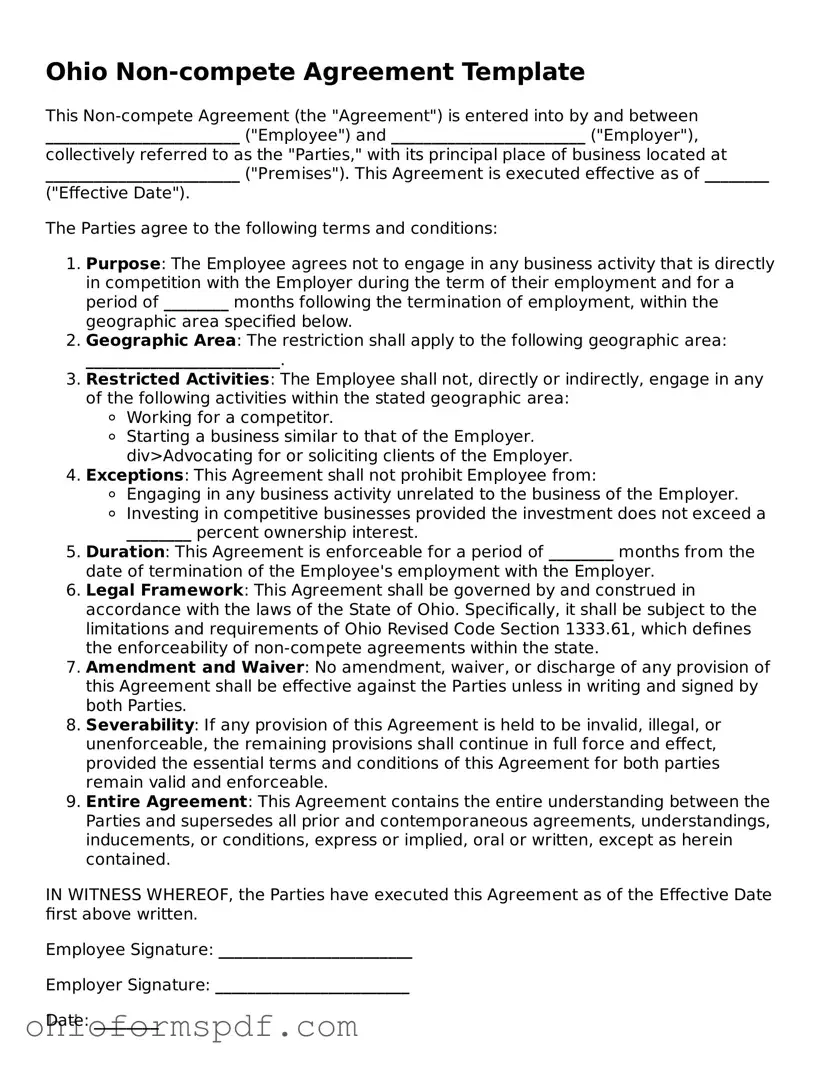What is a Non-compete Agreement in Ohio?
A non-compete agreement in Ohio is a legal document that companies use to prevent their employees from entering into competition with them either during or after their employment period. It restricts employees from working for competitors or starting a business that competes with the employer's business for a specified time and within a certain geographical area.
Are Non-compete Agreements enforceable in Ohio?
In Ohio, non-compete agreements are generally enforceable if they are considered reasonable. This means the agreement must protect legitimate business interests, such as confidential information or trade secrets, not impose undue hardship on the employee, and not harm the public interest. The specifics of what is considered reasonable may depend on the industry and the roles involved.
What makes a Non-compete Agreement reasonable in Ohio?
A non-compete agreement is considered reasonable in Ohio if it does not last for more than a necessary duration, typically not more than two years, and covers a geographical area that is reasonable and not excessively broad. Furthermore, it must protect a legitimate business interest of the employer, such as investment in training the employee or access to sensitive information.
Can an employee negotiate a Non-compete Agreement in Ohio?
Yes, employees have the right to negotiate the terms of a non-compete agreement before signing. This can include discussions about the duration of the restriction, the geographical scope, and what constitutes competing activities. It's wise for employees to review the agreement carefully and consider seeking legal advice to negotiate terms that are fair and reasonable.
What happens if an employee breaks a Non-compete Agreement in Ohio?
If an employee in Ohio breaks a non-compete agreement, the employer may take legal action against the employee. The employer can seek a court order to stop the employee from continuing the prohibited activity and may also sue for damages if they can prove that the breach of the non-compete caused financial harm to their business.
Can a Non-compete Agreement be modified or voided after signing in Ohio?
Yes, a non-compete agreement can be modified or voided after signing if both the employer and employee agree to the changes. Additionally, a court in Ohio has the power to modify an agreement if it finds the terms to be unreasonably restrictive. However, this is determined on a case-by-case basis.
Does an employee have to sign a Non-compete Agreement in Ohio?
An employer in Ohio can require an employee to sign a non-compete agreement as a condition of employment. However, the employee can choose not to sign the agreement. This decision, though, may result in not being hired or, if already employed, could lead to termination or other changes to the employment arrangement, depending on the policies of the company.
Are there any professions exempt from Non-compete Agreements in Ohio?
In Ohio, certain professionals may be exempt from non-compete agreements, depending on specific laws and regulations that apply to their profession. For example, there are often exceptions for medical professionals. It's important to consult with a legal expert or do detailed research about your specific profession to understand if any exemptions apply.
How can an individual dispute a Non-compete Agreement in Ohio?
An individual can dispute a non-compete agreement in Ohio by seeking legal advice and potentially filing a lawsuit to challenge the agreement's enforceability. The court will examine whether the agreement is reasonable in scope, duration, and geographic area and whether it unnecessarily restricts the employee's ability to find employment. Success in disputing the agreement often depends on proving that it is overly restrictive and not necessary to protect the employer's legitimate business interests.
